 W
WAcroneuria lycorias or the boreal stonefly is a species of stonefly native to North America. It was first described by Edward Newman in 1839. The species is named after the Nereid Lycorias of Greek mythology.
 W
WAedes canadensis, the woodland pool mosquito, is an aggressive, day biting mosquito that can be a vector of a number of diseases which is found mainly in eastern North America.
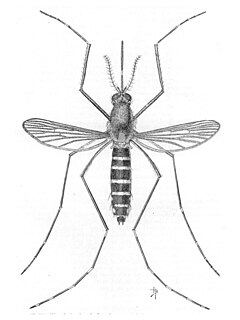 W
WAedes taeniorhynchus, or the black salt marsh mosquito, is a mosquito in the family Culicidae. It is a carrier for encephalitic viruses including Venezuelan equine encephalitis and can transmit Dirofilaria immitis. It resides in the Americas and is known to bite mammals, reptiles, and birds. Like other mosquitoes, Ae. taeniorhynchus adults survive on a combination diet of blood and sugar, with females generally requiring a blood meal before laying eggs.
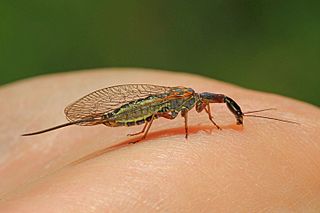 W
WAgulla is a genus of modern snakeflies in the family Raphidiidae.
 W
WAnisomorpha buprestoides is a stick insect which occurs throughout the southeastern United States.
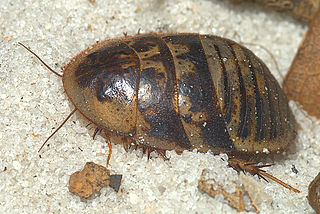 W
WArenivaga floridensis is a species of sand cockroaches of the subfamily Corydiinae, in the family Corydiidae. It is a fossorial insect endemic to the Florida sand ridge. Its natural habitats are scrubland and sandhill communities on ancient ridges in peninsular Florida.
 W
WBoisea rubrolineata or the western boxelder bug is identical to the boxelder bug aside from having prominent red veins on its corium. It is found on the west of North America.
 W
WBoyeria vinosa, the fawn darner, is a species of dragonfly in the family Aeshnidae. It is found in south-eastern Canada and eastern USA. Its natural habitat is rivers. They are most active at dusk.
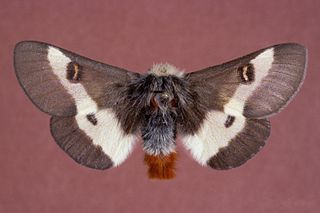 W
WThe buck moth is a common insect found in oak forests, stretching in the United States from peninsular Florida to New England, and as far west as Texas and Kansas. It was first described by Dru Drury in 1773. The larvae typically emerge in a single generation in the spring. The larvae are covered in hollow spines that are attached to a poison sac. The poison can cause symptoms ranging from stinging, itching and burning sensations to nausea. Subspecies Hemileuca maia maia is listed as endangered in the US state of Connecticut.
 W
WChrysoperla carnea, known as the common green lacewing, is an insect in the Chrysopidae family. Although the adults feed on nectar, pollen and aphid honeydew, the larvae are active predators and feed on aphids and other small insects. It has been used in the biological control of insect pests on crops.
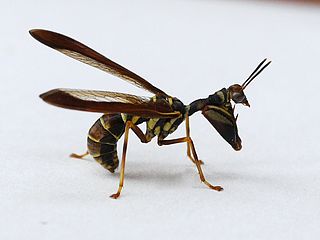 W
WClimaciella brunnea, known sometimes by the common names wasp mantidfly and Brown mantidfly, is a predatory neuropteran insect in the family Mantispidae.
 W
WCloeon dipterum is a species of mayfly with a Holarctic distribution. It is the most common mayfly in ponds in the British Isles and the only ovoviviparous mayfly in Europe. Males differ from females in having turbinate eyes.
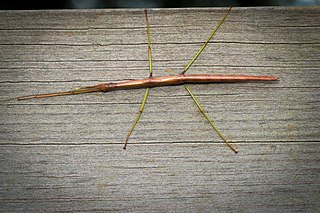 W
WThe common walkingstick or northern walkingstick is a species of phasmid or stick insect found across North America. The average length of this species is 75mm (3 in) for males and 95mm (3.7 in) for females.
 W
WThe eastern dobsonfly, Corydalus cornutus, is a large insect in the Corydalidae family. It is found in eastern North America in regions with fast-flowing streams where its aquatic larvae develop. These are known as hellgrammites and are among the top invertebrate predators in the streams in which they live. They are used by anglers as bait.
 W
WDasymutilla gloriosa, sometimes referred to as the thistledown velvet ant, is a member of the genus Dasymutilla. Only females are wingless, as in other mutillids. It ranges from Utah, Nevada, California, Arizona, New Mexico, Texas and south into Mexico.
Diapheromera covilleae, the creosote bush walkingstick, is a species of stick insect in the family Diapheromeridae. They are about 5 to 10 centimetres long depending on the sex, with large tarsal hooks at the end of each leg for superior grip to branches or other objects. They have small eyes and horn-like spines on the head and anus. Since they do not have wings, they travel by walking along branches of trees and bushes, sometimes walking along the ground in search for the next perch or food source. Females are usually 3 to 4 centimetres longer than males and have a larger body. Females are also grey in color while males are more brown.
 W
WReticulitermes flavipes, the eastern subterranean termite is the most common termite found in North America. These termites are the most economically important wood destroying insects in the United States and are classified as pests. They feed on cellulose material such as the structural wood in buildings, wooden fixtures, paper, books, and cotton. A mature colony can range from 20,000 workers to as high as 5 million workers and the primary queen of the colony lays 5,000 to 10,000 eggs per day to add to this total.
 W
WEphemera guttulata or the eastern green drake is a species of mayfly in the genus Ephemera. The eastern green drake is native to the continental United States and Canada. Its conservation status per the NatureServe conservation status ranking system is G5, meaning it is secure.
 W
WEphemera simulans is a species of mayfly. It is commonly found throughout the United States. The species is used for fly fishing.
 W
WEpimartyria bimaculella is a species of moth belonging to the family Micropterigidae. It was described by Davis and Landry in 2012. It is found in north-western Washington and southern British Columbia.
 W
WThe Florida woods cockroach or palmetto bug is a large cockroach species which typically grows to a length of 30–40 mm (1.2–1.6 in). When alarmed, adults can eject an extremely foul-smelling directional spray up to 1 m, which inspired several of its other common names: Florida skunk roach, Florida stinkroach, skunk cockroach, skunk roach, stinking cockroach, and stinkroach. Two other naming variations include Florida cockroach and Florida woods roach.
 W
WFrankliniella tritici, the eastern flower thrips, is a species of thrips in the genus Frankliniella. F. tritici inhabits blossom, such as dandelion flowers. They can directly damage plants, grasses and trees, in addition to commercial crops, and as a vector for tospoviruses, a form of plant virus, it particularly affects small fruit production in the United States, including strawberries, grapes, blueberries and blackberries. It can also affect alfalfa, oats, beans and asparagus crops. The species features strap-like wings edged with long hairs, a design which increases aerodynamic efficiency in very small arthropods; the reduced drag means the insect uses less energy. They extract nutrients directly from individual plant cells, and may also digest cells of fungi in the leaf litter.
 W
WHylobittacus apicalis is a species of hangingfly in the order Mecoptera, and the only species within the genus Hylobittacus.
 W
WIncisitermes minor is a species of termite in the family Kalotermitidae known commonly as the western drywood termite. It is native to western North America, including the western United States and northern Mexico. It has been found in many other parts of the United States, all the way to the East Coast. It has been reported from Toronto. It has been introduced to Hawaii. It has been noted in China and it is not uncommon in Japan. This is an economically important pest of wooden structures, including houses. In California and Arizona alone its economic impact is estimated to be about $250 million per year.
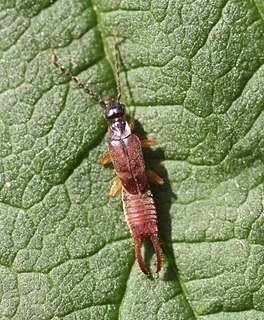 W
WLabia minor, the lesser earwig or small earwig, is a species of earwig. It is widespread globally in temperate climates, preferring warm locations such as compost heaps in parts of its range. It is 4–7 mm long, including the pincer, and chocolate brown in color.
 W
WLednia is a monotypic genus, containing the single species Lednia tumana —a rare, alpine, aquatic insect that is endangered due to likely loss of glaciers and snowpacks in the Glacier National Park and other habitat in the Rocky Mountains due to climate change. The insect lives in the coldest streams just downstream of the glacier or snowbank sources and is considered as an early warning indicator species of climate warming in mountain ecosystems. The Fisheries and Wildlife Service is being petitioned to protect the species under the U.S..Endangered Species Act.
 W
WLeptophlebia marginata, the sepia dun, is a species of mayfly in the family Leptophlebiidae. It is native to Europe and North America where it is distributed widely near lakes, ponds and slow-moving streams. The larvae, which are known as nymphs, are aquatic.
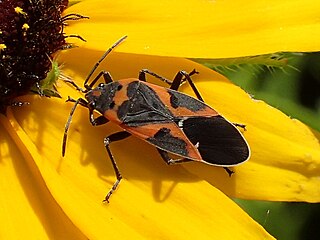 W
WLygaeus kalmii, known as the small milkweed bug or common milkweed bug, is a species of seed bug in the family Lygaeidae. It is found in Central America and North America.
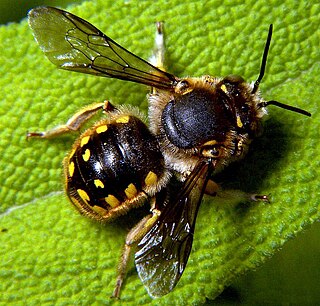 W
WMegachilidae is a cosmopolitan family of mostly solitary bees whose pollen-carrying structure is restricted to the ventral surface of the abdomen. Megachilid genera are most commonly known as mason bees and leafcutter bees, reflecting the materials from which they build their nest cells ; a few collect plant or animal hairs and fibers, and are called carder bees, while others use plant resins in nest construction and are correspondingly called resin bees. All species feed on nectar and pollen, but a few are kleptoparasites, feeding on pollen collected by other megachilid bees. Parasitic species do not possess scopae. The motion of Megachilidae in the reproductive structures of flowers is energetic and swimming-like; this agitation releases large amounts of pollen.
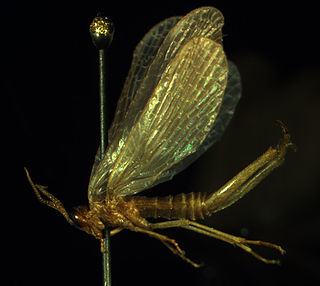 W
WMerope tuber, the earwigfly or forcepfly, is the only species in the genus Merope, and the only living member of the family Meropeidae in North America. It occurs throughout the east from Ontario to Georgia, and west to Kansas. Recently the insect has also been found in Florida. This insect's most distinguishing feature is the segmented cerci on the male abdomen. The function of these is not known, but they may be used during courtship. Much is unknown about the adults, which are nocturnal and secretive, sometimes found under logs or in malaise traps near streams, or attracted to lights at nighttime. No M. tuber or Meropeid larvae have been identified. The insect is characterized by long wings with many veins and no ocelli. There is a region of interlocking sclerites that holds the jugum and scutellum on the middle thoracic segment together. This may be used to keep the wings together when pushing up through dirt. A similar apparatus is found in cicadas and ground-dwelling beetles, so it may be that the winged adults dig in soil. The flat appearance of the insect suggests that the insect dwells close to the ground in fissures and other small ground openings, as does the lack of ocelli.
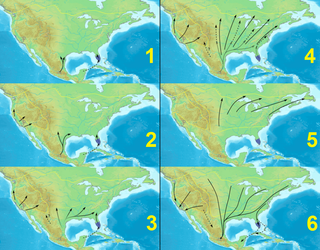 W
WMonarch butterfly migration is the phenomenon, mainly across North America, where the subspecies Danaus plexippus plexippus migrates each summer and autumn to and from overwintering sites on the West Coast of California or mountainous sites in Central Mexico. Other subspecies perform minor migrations or none at all. This massive movement of butterflies has been called "one of the most spectacular natural phenomena in the world".
 W
WNeostylopyga rhombifolia, the harlequin roach, is a species of cockroach in the family Blattidae. It is found in North America, Oceania, and Southern Asia.
 W
WNigronia serricornis has many common names including; hellgrammites or fishflies or saw-combed fishfies. The genus Nigronia has one other North American member N. fasciatus which lives in much of the same territory and is quite similar in all regards. They are holometabolous insects with an aquatic larval stage. N. serricornis is a common inhabitant of woodland streams in North America and they are often the largest insect predator found in 2nd and 3rd order streams. The larvae are a sit-and -wait ambush predators that feed on a large variety of invertebrates. Studies have shown that N. serricornis has a varying diet throughout the seasons.
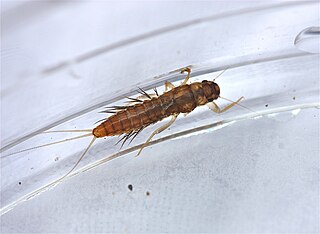 W
WParaleptophlebia is a genus of mayflies in the family Leptophlebiidae. Commonly found in North America, Britain, and parts of Western Europe.
 W
WParcoblatta americana, the western wood cockroach, is a species of wood cockroach that occurs in Mexico and the western United States.
 W
WThe Peltoperlidae, also known as roach-like stoneflies or roachflies, are a family of stoneflies.
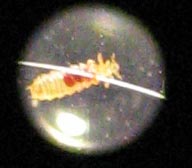 W
WPolyplax spinulosa is a sucking louse (Anoplura) from the genus Polyplax. It occurs worldwide and commonly infects its type host, the brown rat, and related species like the black rat, Rattus pyctoris, Rattus nitidus, Rattus argentiventer, Rattus tanezumi, Rattus exulans, and Bandicota indica. It is also occasionally found in other rodents, such as the marsh rice rat in North America.
 W
WThe Pteronarcyidae, also known as giant stoneflies or salmonflies, are a family of the order Plecoptera.
 W
WPteronarcys californica is a species of insect in the family Pteronarcyidae, the giant stoneflies and salmonflies. It is known commonly as the giant salmonfly.
 W
WThe Rocky Mountain locust is an extinct species of grasshopper that ranged through the western half of the United States and some western portions of Canada with large numbers seen until the end of the 19th century. Sightings often placed their swarms in numbers far larger than any other locust species, with one famous sighting in 1875 estimated at 198,000 square miles (510,000 km2) in size, weighing 27.5 million tons and consisting of some 12.5 trillion insects, the greatest concentration of animals ever speculatively guessed, according to Guinness World Records.
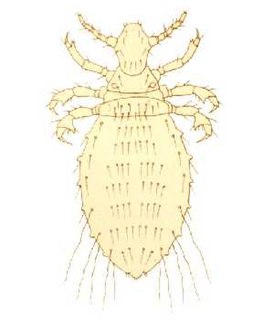 W
WThe little blue cattle louse is the common name for the Solenopotes capillatus in the United States but is known as the tubercle-bearing louse in Australia. This louse is the smallest of the sucking lice that occur on cattle and is a relatively immobile species. They are found all around the world in distribution but are restricted mainly to areas with domestic livestock. The little blue cattle louse is most often found on the head of its host, primarily the face and jaw region, but sporadically is found on other body parts. It is relatively immobile so typically will not relocate on its host's body. The louse is spread by direct contact and is considered an ectoparasite.
 W
WStenoptilodes antirrhina, the snapdragon plume moth, is a moth of the family Pterophoridae. It is known from California in the United States, but also from greenhouses in the south-eastern U.S. that have received cuttings of snapdragon from California.
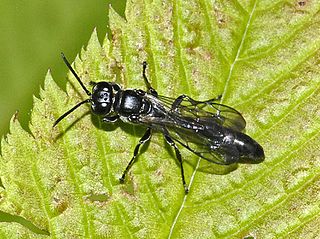 W
WTrypoxylon is a genus of wasps in the family Crabronidae. All Trypoxylon species that have been studied so far are active hunters of spiders, which they paralyse with a venomous sting, to provide as food to their developing larvae. Depending on the species, they will either construct their own nest from mud or find cavities that already exist. These cavities can range from keyholes to nail holes to previously abandoned nests, and are generally sealed with mud to create cells for their larvae.
 W
WXenos vesparum is an insect species, whose females are permanent entomophagous endoparasites of Polistes paper wasps. They dwell their entire lifespan in the abdomen of the wasp. Two particular species of social wasp it has been known to infect are Polistes gallicus and Polistes dominula. Younger members of a wasp colony tend to be targeted, although X. vesparum displays parasitic behavior in all stages of this host.
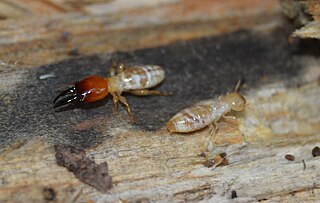 W
WZootermopsis is a genus of termites in the Dampwood termite family (Archotermopsidae). They are mostly found in western North America, ranging from Canada to Mexico, with the exception of Z. nevadensis, which has become established in Japan. They live in rotting wood, commonly inhabiting fallen or dead trees in North America's temperate rain forests, where they break down the wood's cellulose with the help of symbiotic protozoa and bacteria in their stomachs. The life and reproductive cycles of these termites are relatively normal compared to other members of its family. Species can be identified using the shape and position of the subsidiary tooth in all non-soldier castes, allowing a more certain identification than the previous method, which was based on the more ambiguous morphology of soldiers.
 W
WZootermopsis angusticollis is a species of termite (Isoptera) in the family Archotermopsidae, a group known as the dampwood termites, or the rottenwood termites. As their name suggests, the dampwood termites can only survive by living off of wood that contains high amounts of moisture. They are found along the wet environments of the Pacific coast of North America. Most are found in the states of California, Oregon, Washington, Idaho, Western Nevada and in southern British Columbia. Termites are well known to be destroyers of wood, and although the dampwood termites can cause some damage, they are not as notoriously known to cause as much damage to buildings as the drywood termites. They occasionally have been carried to other parts of the country through wood shipments, but have not been able to become established in these areas due to undesirable environmental conditions.
 W
WZootermopsis nevadensis is a species of eusocial termite (Isoptera) in the family Archotermopsidae, a group known as the dampwood termites. It is a hemimetabolous organism. Eusociality evolved independently within several orders of insects, directed by different selection pressures. Nevertheless, termites and other eusocial insects from Hymenoptera evolved similar physiological and social characteristics.